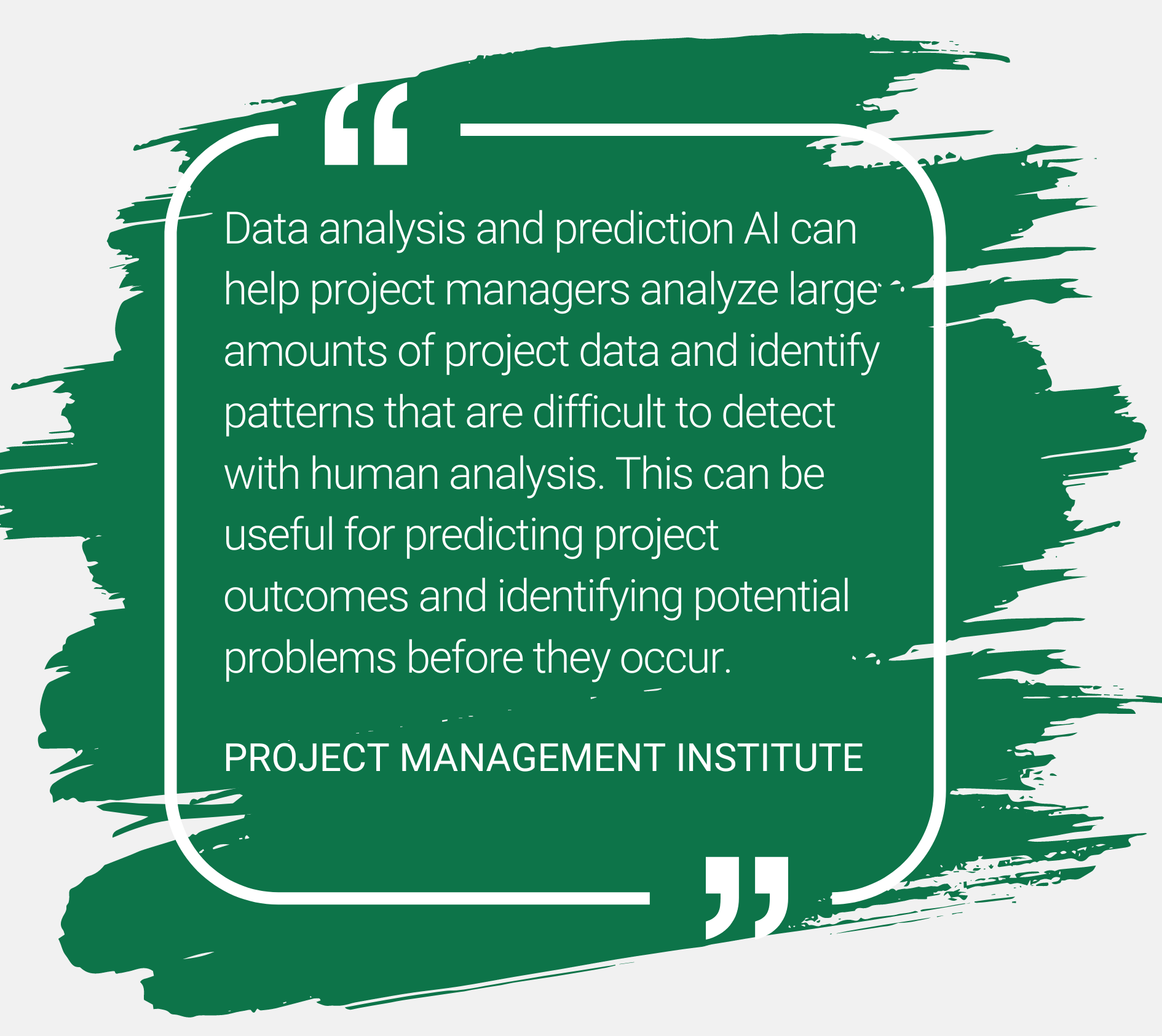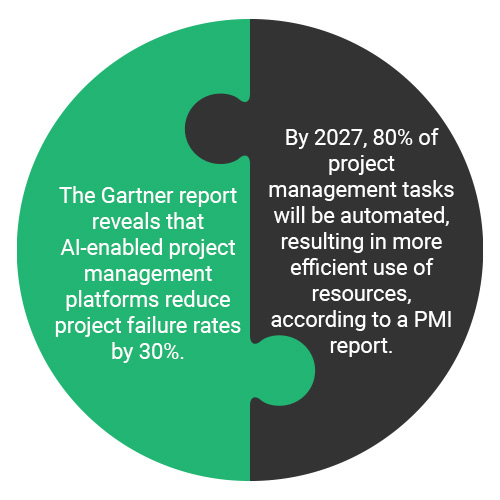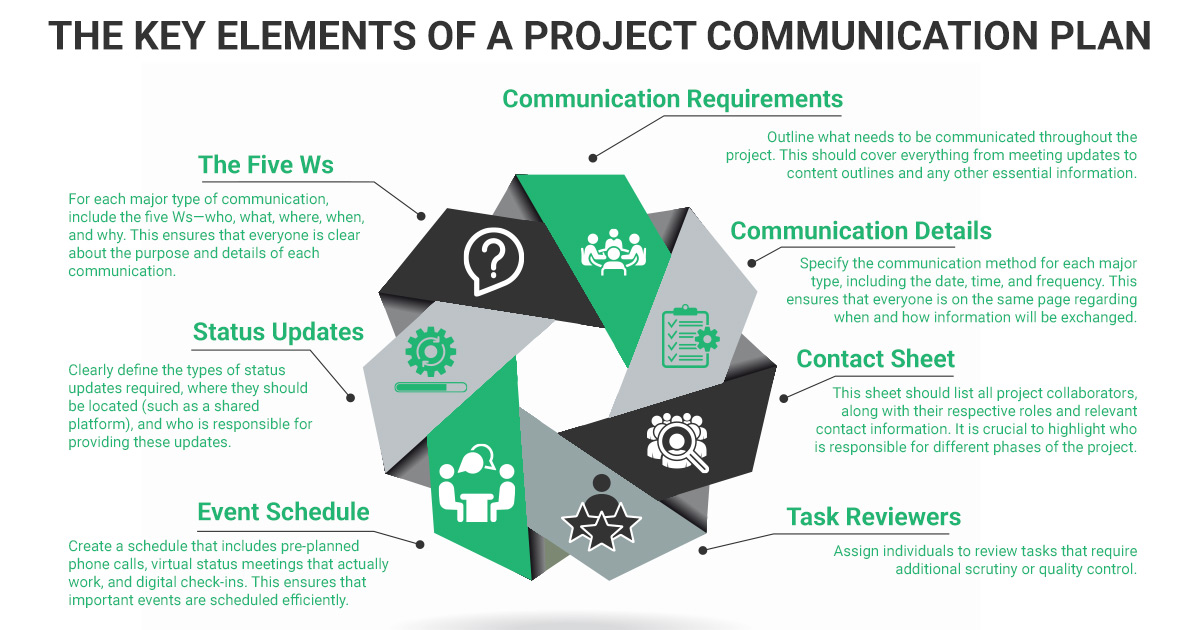
As a project leader, you find yourself constantly juggling many responsibilities. These include tracking your team members, crafting realistic schedules, managing tasks, dealing with project deadlines, and sometimes handling difficult stakeholders. We know it is a demanding role within any organization. But have you ever wondered what separates highly successful project leaders from the rest? Are they more adept at persuading team members to meet project deadlines, or is there a hidden secret behind their accomplishments? Often, a key factor makes all the difference, and it is not much of a secret: having a robust project communication plan.
Utilizing modern technology solutions like predictive analytics possess the capability to rapidly analyze extensive datasets, extract critical information, and generate detailed reports with unmatched speed and accuracy. This efficiency saves valuable time and guarantees stakeholders timely and consistent updates, aiding in well-informed decision-making.
Today’s advanced solutions meticulously sift through massive data volumes, identifying key insights and producing thorough reports with exceptional precision. This accelerates the reporting process while maintaining consistency and accuracy in delivering crucial project information to stakeholders and team members. In this article, we will explore the critical components of a project communication plan, the impact of digital technologies on a project communication plan, strategies for effective communication, and tips to overcome communication breakdowns and conflicts.
What Is a Project Communication Plan?
A project management communication plan is like a roadmap for sharing important information during the project execution. It outlines how, when, why, and to whom information will be shared. It is essential for managing stakeholder expectations, ensuring alignment and collaboration, and avoiding conflicts. Furthermore, this plan is a valuable tool, helping team members and stakeholders understand what information they will receive and what they won't. It also outlines the preferred communication channels for the project. As a project leader, you play a pivotal role in crafting and executing these plans, and it is essential to get them right.
Why Does an Effective Project Communication Plan Matter?
 Without solid communication skills, you risk having work duplicated or missing essential steps. Even worse, poor communication can cause projects to drift far from their intended goals, potentially leading to failure or being scrapped altogether. According to a PMI survey, 30% of respondents identified "poor communication" as the primary reason for scope gaps and project failure. Given the potential consequences of failure, it is no surprise that a communication plan is essential for every project you undertake.
Without solid communication skills, you risk having work duplicated or missing essential steps. Even worse, poor communication can cause projects to drift far from their intended goals, potentially leading to failure or being scrapped altogether. According to a PMI survey, 30% of respondents identified "poor communication" as the primary reason for scope gaps and project failure. Given the potential consequences of failure, it is no surprise that a communication plan is essential for every project you undertake.
So, how do you ensure everyone remains on the same page throughout your project for the best results?
Remember, your team is a mix of individuals with diverse backgrounds, skills, and work styles. So, it is crucial to understand your team members' preferences and communication styles to ensure effective communication. This way, you can bridge gaps and ensure everyone is on the same page and working towards a common goal. With an effective project communication plan, you can successfully work through tasks and meet deadlines.
Challenges of Creating and Implementing Project Communications Management Plan
Of course, it is not all smooth sailing. Implementing a communication plan is easier said than done, and communication breakdowns and conflicts are not uncommon. Therefore, it is crucial to be ready for potential project communication challenges. So, what are some of the challenges you might encounter?
Clarity Hurdles
This arises when you are unsure about your goals, audience, message, or how to convey them. This lack of clarity can lead to vague, inconsistent, or irrelevant messages that fail to resonate with your intended audience or support your objectives.
Resource Constraints
Another challenge often encountered with a poor project communication plan is a shortage of resources, such as time, money, staff, or tools, to execute the project processes effectively. This scarcity can result in missed deadlines, diminished quality, or limited reach for your communication efforts.
Feedback Drought
Without a platform to collect, analyze, and utilize feedback from your audience, partners, or stakeholders, you can face communication gaps, misunderstandings, and missed opportunities.
Engagement Shortfall
Engagement can be a significant challenge if you lack strategies to capture and maintain your audience's attention, interest, and action. This can result in low awareness, recall, or loyalty to your messages or brand.
Identity Ambiguity
This occurs when you lack a unique value proposition or identity distinguishing you from competitors or alternatives. This lack of differentiation can lead to confusion or indifference toward your messages or brand.
Integration Issues
Integration issues occur when your communication strategies and execution are inconsistent across various channels, platforms, or activities. This lack of integration can result in fragmented, duplicated, or contradictory messages.
How do you address these issues head-on and be proactive in finding solutions?
The Key Components of a Project Communication Plan
A robust communication plan has become more crucial in this post-pandemic working world. Many workplaces have transitioned to a hybrid or fully remote work setup, scattering teams across different locations and time zones. In this new landscape, effective communication must take center stage. So, how can you create project communication plans that meet the demands of the digital age?

By leveraging modern technologies such as predictive intelligence, which allows real-time communication and collaboration, we can bridge the gap between team members across the globe. Additionally, predictive intelligence analyzes project data and forecasts the probability of a project exceeding its budget or falling behind schedule. It also enhances resource allocation capabilities by identifying each task's most effective resource utilization. Furthermore, predictive intelligence monitors project advancement in real-time, promptly notifying you of potential concerns and empowering you to take swift corrective action.
Integrating predictive intelligence in project planning provides enhanced decision-making tools, leads to improved project outcomes, and streamlines project execution procedures for greater efficiency. It is no longer just about sending emails and scheduling meetings but about fostering meaningful connections and ensuring everyone is in sync. Are you wondering what elements you should include in a solid project communication plan? Look at the below image for a detailed breakdown of the essential components that should be included in every effective communication plan:
Strategies for Effective Project Communication
According to research conducted by PMI (Project Management Institute), project managers dedicate approximately 70–90% of their time to communicating what needs to be accomplished in a project. While we have emphasized the significance of a project communication plan, remember that communication holds actual value only when it is effective and thoughtfully organized. Here are some strategies to improve your communication plan and drive success:
![]() Understand Your Audience: When communicating within a project, recognize that different stakeholders have diverse needs, preferences, and perspectives related to the project. So, take the time to identify and analyze your audience and tailor your message and delivery to suit their specific requirements.
Understand Your Audience: When communicating within a project, recognize that different stakeholders have diverse needs, preferences, and perspectives related to the project. So, take the time to identify and analyze your audience and tailor your message and delivery to suit their specific requirements.
![]() Systematically Plan Your Communication: Create a communication plan outlining the purpose, scope, methods, roles, and responsibilities. This plan serves as your roadmap, ensuring you convey the correct information to the right people at the right time and in the right way. Include feedback mechanisms like surveys, meetings, or reviews to measure effectiveness and make necessary adjustments.
Systematically Plan Your Communication: Create a communication plan outlining the purpose, scope, methods, roles, and responsibilities. This plan serves as your roadmap, ensuring you convey the correct information to the right people at the right time and in the right way. Include feedback mechanisms like surveys, meetings, or reviews to measure effectiveness and make necessary adjustments.
![]() Diversify Your Communication Channels: Depending on the message's nature, complexity, and urgency, use email for updates, phone calls for urgency, video conferencing for interactive discussions, and social media for informal engagement. Visual aids like charts, graphs, or diagrams enhance clarity and conciseness.
Diversify Your Communication Channels: Depending on the message's nature, complexity, and urgency, use email for updates, phone calls for urgency, video conferencing for interactive discussions, and social media for informal engagement. Visual aids like charts, graphs, or diagrams enhance clarity and conciseness.
![]() Listen: Acknowledge others' viewpoints, concerns, and emotions. Practice active listening and demonstrate empathy to foster collaboration and resolve conflicts.
Listen: Acknowledge others' viewpoints, concerns, and emotions. Practice active listening and demonstrate empathy to foster collaboration and resolve conflicts.
![]() Communicate Your Project’s Value: Show alignment with strategic goals and objectives. Value extends beyond project output; it encompasses outcomes and benefits. Communicate this value consistently, using metrics like ROI, customer satisfaction, or quality improvement.
Communicate Your Project’s Value: Show alignment with strategic goals and objectives. Value extends beyond project output; it encompasses outcomes and benefits. Communicate this value consistently, using metrics like ROI, customer satisfaction, or quality improvement.
![]() Seek Feedback: Be open to suggestions and criticisms and reflect on your communication performance. Set goals and action plans for improvement, recognizing that growth as a project leader and communicator is ongoing.
Seek Feedback: Be open to suggestions and criticisms and reflect on your communication performance. Set goals and action plans for improvement, recognizing that growth as a project leader and communicator is ongoing.
The Way Forward
In the world of project management, where the stakes are high and the challenges are abundant, the role of an effective communication plan cannot be overstated. The critical factor separates highly successful project leaders from the rest. The key to this success lies in crafting a well-structured project communication plan, a roadmap that guides the flow of crucial information, aligns stakeholders, and fosters collaboration. Poor communication has been identified as a leading cause of project failures, emphasizing the importance of getting it right. Project leaders must proactively seek solutions to address the challenges that may arise in creating and implementing a project communication plan, including clarity hurdles, resource constraints, feedback droughts, engagement shortfalls, identity ambiguities, and integration issues. But how? The answer lies in leveraging modern solutions such as artificial intelligence-powered predictive intelligence that proactively predict, prevent, and overcome challenges before they disrupt your project outcomes.
One such solution, TrueProject, a KPI-based predictive project management SaaS solution, transforms project management processes by providing valuable insights into project data, predicting outcomes, and monitoring project progress in real-time. Its automated, phase-by-phase QA reviews of your projects compare operational reality with desired quality to create a plan of action. You can also leverage phase gates and project data feeds to check for improved productivity and consistency.
In today's digital age, where remote and hybrid work setups are prevalent, mastering the art of communication through modern technologies is paramount. With the right communication plan, you can confidently lead your teams to achieve outstanding results and make your mark as a true leader.
 About the Author:
About the Author:
Nivedita Gopalakrishna is a content marketing specialist within the TrueProject Marketing team with extensive experience in blog writing and website content creation across diverse industries. Nivedita’s proficiency in crafting engaging blog posts and informative website content is a testament to her years of experience. Beyond her prowess in written communication, Nivedita has a knack for creating visually appealing static graphics that have played a pivotal role in expanding TrueProject's marketing efforts. She has helped convey the brand’s essence through thoughtful design choices and captivate audiences effectively. Outside the professional sphere, Nivedita is a trained classical singer and a fitness enthusiast, embodying creativity and wellness in and out of the office.
Endnotes:
- York, Alex. “Building a project management communication plan: What is it and why you need one.” Teamwork.com, June 12, 2023. https://www.teamwork.com/blog/communication-plan-project-management/
- Holloway, Yuquan. “The Role of Communication in Project Management.” LinkedIn, February 20, 2023. https://www.linkedin.com/pulse/role-communication-project-management-yuquan-holloway-pmp/
- “How do you leverage communication to promote project success and value?” LinkedIn, (n.d.). https://www.linkedin.com/advice/1/how-do-you-leverage-communication-promote-project
- Waida, Maria. “What Is a Project Communication Plan?” Wrike, April 21, 2022. https://www.wrike.com/blog/what-is-a-project-communication-plan/#:~:text=A%20project%20communication%20plan%20is,included%20in%20this%20written%20guide
- McAbee, Jeremy. “4 Ways Digital Transformation Is Changing Project Management.” Wrike, October 9, 2021. https://www.wrike.com/blog/digital-transformation-changing-project-management/
- Reddi, Latha Thamma. “How AI will help Project Planning.” ProjectManagement.com, March 26, 2023. https://www.projectmanagement.com/wikis/849920/how-ai-will-help-project-planning#_=_
- “What communication plan challenges do you face?” LinkedIn, (n.d.). https://www.linkedin.com/advice/1/what-communication-plan-challenges-do#:~:text=Another%20common%20communication%20plan%20challenge,reach%20of%20your%20communication%20activities
- McGaughy, Cameron et al. “Are Your Communication Habits Good Enough?” ProjectManagement.com, (n.d.). https://www.projectmanagement.com/blog-post/18979/Are-Your-Communication-Habits-Good-Enough--





